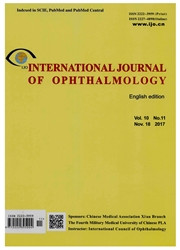

 中文摘要:
中文摘要:
AIM: To investigate the infiltration and activation of lymphocyte in iris-ciliary body and anterior chamber after allogenic penetrating keratoplasty (PK), for further revealing the role of iris-ciliary body in corneal allograft immune rejection. METHODS: In the mice models of PK, BALB/C mice received orthotopic isografts (n =35) or C57BL/6 donor allografts (n =25). Grafts were examined daily for 3 weeks by slit-lamp microscopy and scored for opacity. The infiltration of CD4+ T lymphocyte in iris-ciliary body and anterior chamber was examined by immunohistology and the mRNA of CD80 and CD86 in both cornea graft and iris-ciliary body by RT-PCR was analyzed in allograft recipient at days 3, 6, 10 and the day when graft rejection occurred. Isograft recipients were examined as control at the corresponding time points. Transmission electron microscope was used to study the ultrastructure, especially cell infiltration, of iris-cilary body and corneal graft at day 3, 7 and the day when rejection occurred after allogenic PK. RESULTS: Rejection was observed in all the allograft recipients followed more than 10 days, at a median time of 15 days (range 12-18 days), but not in any of isografts. CD4+ T cells were first detected at day 6 after transplantation in limbus and Ciliary body, and then in the stroma of recipient, iris, anterior chamber and corneal allograft with an increased number until graft rejection occurred. CD80 and CD86 mRNA were detected under RT-PCR examination in both graft and iris-ciliary body of allograft recipient, but not in any of isograft recipient. Three days after operation, lymphocytes and monocytes macrophages were visible in iris blood vessels and the anterior chamber, and vascular endothelial cell proliferation and activation were significant under transmission electron microscopy examination. At day 7, corneal endothelial cells became thinner. Lymphocytes and mononuclear macrophages were found with great number in the anterior chamber and adhered to the corneal endothelium. Blood vessels in ir
 英文摘要:
英文摘要:
AIM: To investigate the infiltration and activation of lymphocyte in iris-ciliary body and anterior chamber after allogenic penetrating keratoplasty (PK), for further revealing the role of iris-ciliary body in corneal allograft immune rejection. METHODS: In the mice models of PK, BALB/C mice received orthotopic isografts (n =35) or C57BL/6 donor allografts (n=25). Grafts were examined daily for 3 weeks by slit-lamp microscopy and scored for opacity. The infiltration of CD4(+) T lymphocyte in iris-ciliary body and anterior chamber was examined by immunohistology and the mRNA of CD80 and CD86 in both cornea graft and iris-ciliary body by RT-PCR was analyzed in allograft recipient at days 3, 6, 10 and the day when graft rejection occurred. Isograft recipients were examined as control at the corresponding time points. Transmission electron microscope was used to study the ultrastructure, especially cell infiltration, of iris-cilary body and corneal graft at day 3, 7 and the day when rejection occurred after allogenic PK. RESULTS: Rejection was observed in all the allograft recipients followed more than 10 days, at a median time of 15 days (range 12-18 days), but not in any of isografts. CD4(+) T cells were first detected at day 6 after transplantation in limbus and Ciliary body, and then in the stroma of recipient, iris, anterior chamber and corneal allograft with an increased number until graft rejection occurred. CD80 and CD86 mRNA were detected under RT-PCR examination in both graft and iris-ciliary body of allograft recipient, but not in any of isograft recipient. Three days after operation, lymphocytes and monocytes macrophages were visible in iris blood vessels and the anterior chamber, and vascular endothelial cell proliferation and activation were significant under transmission electron microscopy examination. At day 7, corneal endothelial cells became thinner. Lymphocytes and mononuclear macrophages were found with great number in the anterior chamber and adhered to the corneal endothelium. Blood vessels in
 同期刊论文项目
同期刊论文项目
 同项目期刊论文
同项目期刊论文
 Risk Factors, Clinical Features, and Outcomes of Recurrent Fungal Keratitis after Corneal Transplant
Risk Factors, Clinical Features, and Outcomes of Recurrent Fungal Keratitis after Corneal Transplant Role of extracellular phospholipase B of Candida albicans as a virulent factor in experimental kerat
Role of extracellular phospholipase B of Candida albicans as a virulent factor in experimental kerat Features of corneal neovascularization and lymphangiogenesis induced by different etiological factor
Features of corneal neovascularization and lymphangiogenesis induced by different etiological factor 期刊信息
期刊信息
